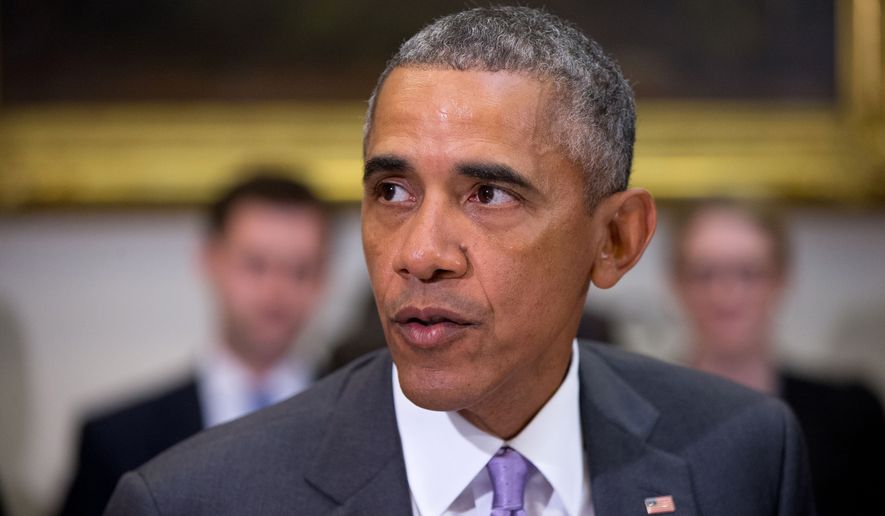President Obama will need to more than double the number of Americans enrolled in Obamacare exchange plans to reach 21 million next year, the target set in budget projections, in what is shaping up as the next major test for the health care law.
As of June, the Department of Health and Human Services counted 9.9 million customers who have bought plans through the federal HealthCare.gov portal and a handful of state-run exchanges.
That puts the administration ahead of its own estimates for 2015, but is less than half what the Congressional Budget Office projected for 2016, showing just how much work officials have ahead of them as the next round of enrollment begins in less than two months.
Industry analysts said the CBO’s estimate for next year is “overly optimistic” and a “stretch,” and that it will take more time for the law to attract that many people onto the Web-based markets, where consumers shop for private health care plans and typically qualify for government subsidies to reduce their monthly premiums.
“Given where things stand, the ramp-up of enrollment may be slower than initially anticipated,” said Elizabeth Carpenter, a vice president at Avalere Health, a D.C.-based consultancy.
Open enrollment for the third go-around of Obamacare’s exchanges begins Nov. 1, and the administration is counting on winning over millions of customers who didn’t sign up the first two years but who could be pressured by the increasing pain of the “individual mandate” tax assessed on those who forgo health insurance.
PHOTOS: See Obama's biggest White House fails
“It is definitely something that people pay attention to,” said Rachel Klein, director of organizational strategy at Families USA, a nonprofit that advocates for affordable health care.
The tax during the first year was $95 or 1 percent of income above the filing threshold — a relatively minor bite. This year, the penalty will be $325 or 2 percent of income, and by 2016 it will be $695 or 2.5 percent of income.
“The substantial increase in penalties under the individual mandate next year is a big wild card,” said Larry Levitt, a senior vice president at the Kaiser Family Foundation, a nonpartisan health policy organization. “We’re in unchartered territory here about how effective these bigger penalties will be in nudging people to get insured.”
“The marketplaces are working,” Mr. Levitt added, “but higher enrollment would both improve the insurance risk pool and reduce the number of Americans uninsured.”
The individual mandate was included in the Affordable Care Act of 2010 to make sure enough healthy Americans signed up, spreading out the costs for higher-risk customers.
A divided U.S. Supreme Court upheld the mandate in 2012 as an appropriate use of Congress’ taxing power.
QUIZ: Are You Smarter Than A Jeopardy Contestant?
But congressional Republicans are still intent on scrapping the health care law, and may use a fast-track budget procedure known as “reconciliation” to take a swing at it.
GOP leaders say they may not be able to eviscerate the law through the budget, but Brendan Buck, a spokesman for House Ways and Means Committee Chairman Rep. Paul Ryan, said repealing the individual mandate is “definitely on the table.”
“This law is only being held together by mandates and coercion, and that’s why we continue to look at ways to repeal the mandates and give people more freedom and choices,” Mr. Buck said.
Even as it struggles to meet the 2016 enrollment projection, the Obama administration is on track on other measures, including a CBO estimate that 17 million fewer people lack insurance this year because of the health care law.
But in setting lofty goals for the exchanges, the CBO estimated the effect of the individual mandate and other potential changes, including the belief that employers would shift workers onto the exchanges or that customers would enter the Obamacare marketplace ahead of late 2017, when they can no longer hold plans that do not comply with the law.
Under political duress, the White House let customers transition to compliant plans to keep Mr. Obama’s notorious promise that people who like their plans can keep them under his law.
Sizing up reality versus long-range estimates, Health and Human Services has begun to set its own, more modest goals for exchange enrollment, ignoring CBO’s guess of 12 million for 2015 and setting the mark at 9.1 million enrollees. So far, it’s besting its less ambitious goal.
The agency says it is doing its own evaluation of the marketplace and will likely announce its enrollment targets for 2016 before signups begin in November.
“At this point, the Congressional Budget Office’s projected enrollment total for 2016 seems overly optimistic,” Mr. Levitt said. “Enrollment may reach that level eventually, but I doubt it will happen by next year.”
• Tom Howell Jr. can be reached at thowell@washingtontimes.com.




Please read our comment policy before commenting.